This fun holiday peppermint soap looks like peppermint candy. Its festive appearance makes it perfect for Christmas time, but that doesn’t mean you can’t enjoy using it year round.
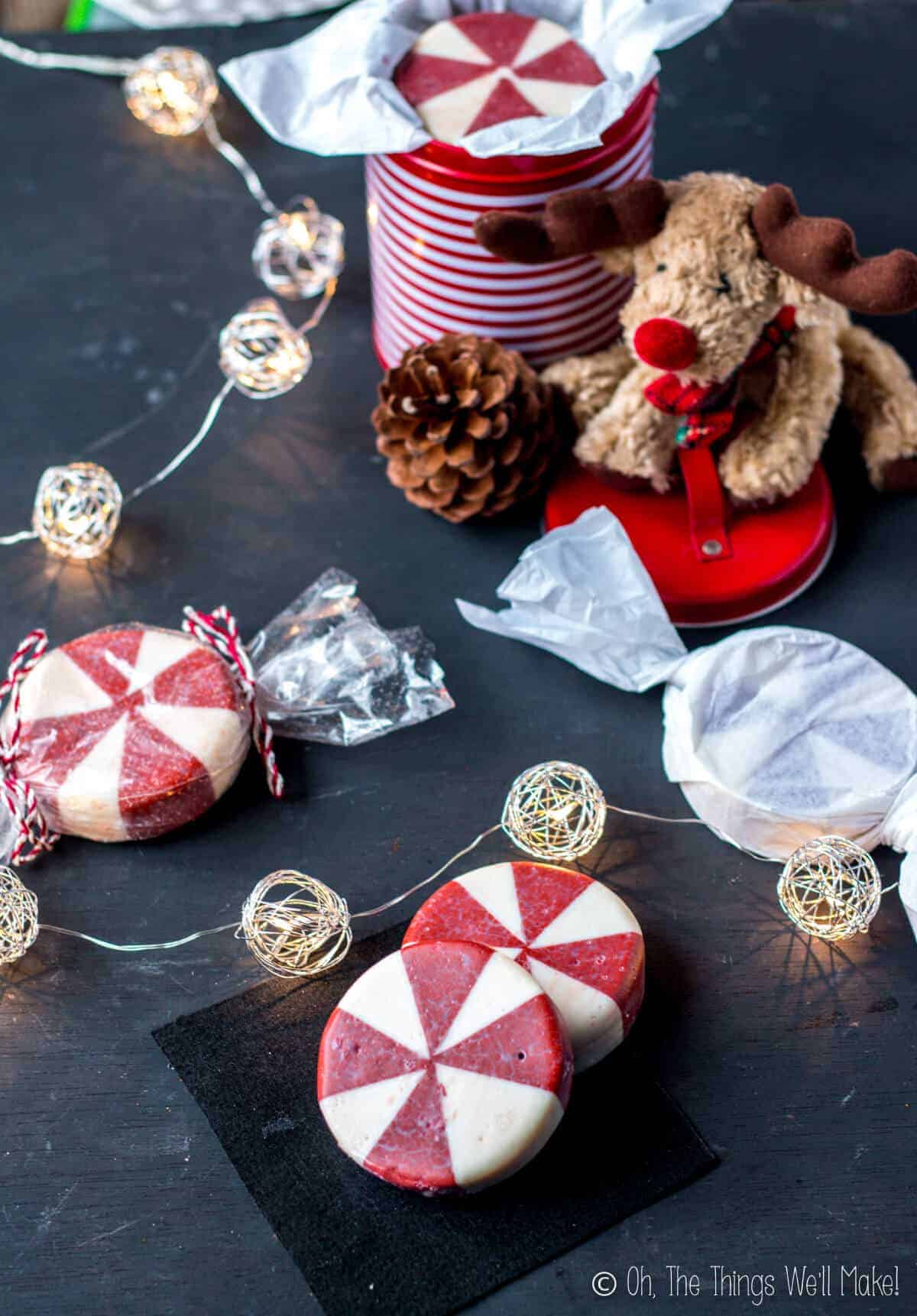
This is one of those fun soaps that makes kids, or kids-at-heart, want to clean up. I made it as a bit of a challenge to myself, but found that in the end, it wasn’t that difficult. It was a great learning experience, and a lot of fun. I did make a few mistakes along the way, but you can learn from those and get perfect results.
Up until now, I haven’t shown you much in the way of coloring soaps, except for making soaps that were naturally colored because of their ingredients. I showed you how to make a black, activated charcoal face soap, and how to swirl in some spices in my pumpkin spice soap, but other than that, the soaps I’ve shared have been pretty natural looking. (If you’re new to making soap, you may want to start here with this easy beginner soap.)
I have done some experimentation with how to dye soaps naturally using mostly spices and clays, and will share a post about that soon, but today I’m sharing a soap recipe that uses a red iron oxide pigment to add a lovely shade of red to this peppermint candy inspired holiday peppermint soap.
What is iron oxide?
Iron oxide is a compound that is comprised of iron and oxygen, and is found in nature. That said, the iron oxides sold for cosmetics are usually synthetic because naturally found iron oxides often contain impurities made up of heavy metals like arsenic, cadmium, and mercury. While I normally try to choose everything as natural as possible, this is a case where the help of a laboratory isn’t all bad. Iron salts are mined, and then oxidized under controlled conditions within a laboratory to keep the heavy metal impurities out.
Iron oxide pigments are often found in natural cosmetics and even organic ones. That’s because they are considered non-toxic and very safe for use. Even people with a lot of skin sensitivities can usually handle iron oxides. They are considered non-irritating and non allergenic.
Making a white colored soap
Most of the soaps that I have shared on this blog have been a light gold color due to the fact that I often use extra virgin olive oil in my soaps. Let’s face it, I live in Spain, and I can find a good quality extra virgin olive oil cheaper than just about any other oil that is good for soap making. Soap lasts a long time, so I prefer to spend a little extra and use the highest quality oils that I can find. The doesn’t mean that I don’t love the frugal idea of refining oils or using oils that you don’t want to use for other purposes for making soap. I just don’t do it very often myself.
To get a white colored soap there are a few tricks to use.
- when using olive oil, use a lighter colored olive oil for a whiter soap. I didn’t use my go-to extra virgin olive oil in this recipe, but instead looked for a lighter olive oil instead.
- Use white colored, solid oils like coconut oil and lard or tallow. These also have the added benefit of making a soap that will harden up more quickly, which is great for a soap embed technique like this one.
- Add a bit of titanium dioxide to the soap to make the white color really “pop”. While this is optional, I had some on hand and decided to give it a try. You can also use zinc oxide instead, if you happen to have it on hand after making my natural deodorant for sensitive skin, but it doesn’t whiten as much as titanium dioxide so you need to add more to get the same effect.
What is a soap embed technique?
Soap embedding is adding something solid within your soap design. You may want to add a loofah within a soap for exfoliation, or embed toys into a transparent glycerin soap to make clean up time more fun for kids. The soap embed technique isn’t always about embedding objects into your soap, though, you can also embed different colored soaps into your main soap to get a pretty colored design.
In some cases, you may want to add little pieces or gratings of one colored soap within a different colored or transparent soap. In this case, I cut pieces of a red soap and set it up in a way that I could fill the empty spaces with a white soap to make a peppermint candy design. Once the soap sets, the different colored soaps fuse together into a pretty, colorful bar of soap.
Making a round mold for soap using PVC pipe
This was also the very first time that I experimented with using PVC pipe as soap mold.
You can make an inexpensive round soap mold using a small piece of PVC pipe that is sealed on one end with a bit of wax or parchment paper (or even some plastic from a plastic bag), held in place with a tight rubber band (or a silicone bracelet).
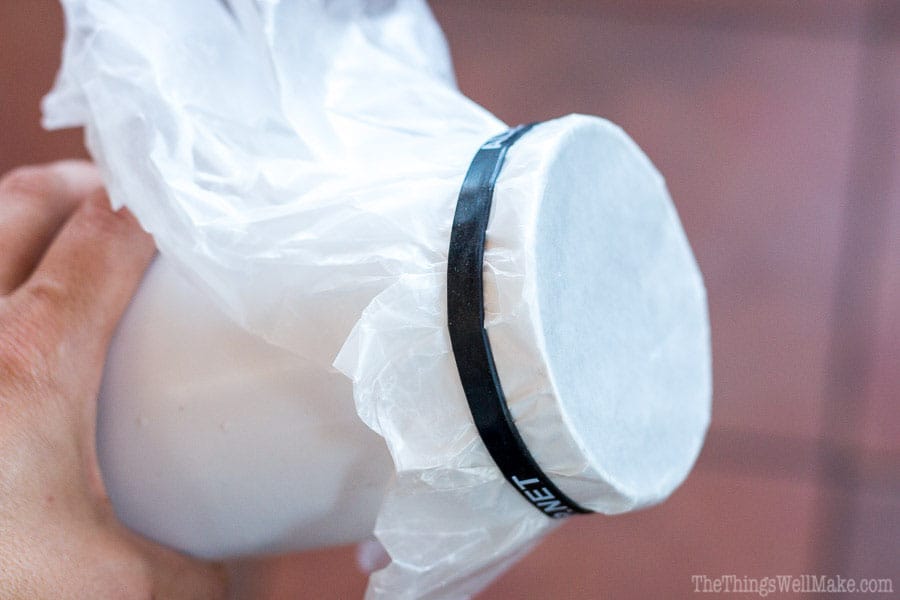
I was a bit worried about the soap sticking and not being able to get the soap out, but I found that it was quite simple after freezing the soap for several hours. Not only does freezing the soap harden it enough to help it keep its shape while you are pressing against it, but it also shrinks the soap slightly, enough to help easily get it out from the tube. I didn’t line my PVC pipe in any way.
The only mistake I made was that I only had one small piece of PVC pipe lying around, so I tried making two layers of soap, one on top of the other, inside the same tube. The top layer of red soap pieces pushed the lower layer out of place, meaning that the bottom soaps weren’t as symmetrical or as pretty as the ones on the top. Had I had two pieces of pipe, I would have made the two layers separately, and I would have had much better results!
Understanding how to use this recipe
You will need to make the below recipe two times to get the results of my soap that looks like a peppermint candy. First, make the recipe below, adding in enough red iron oxide to get the desired color.
After allowing the soap to set for a day or two, you’ll need to freeze it, push it out of the mold, cut it into sections, and place it back into the mold again, this time leaving spaces between each section for the white soap.
You will then need to make the recipe again, this time adding in some titanium dioxide if you want to give the soap a brighter white color, and pour the white soap into the empty sections of the mold. After a couple of days, you can once again freeze the soap, push it out of the mold(s), and cut it into round bars of soap.
Watch me make the holiday peppermint candy soap:
So, are you ready?
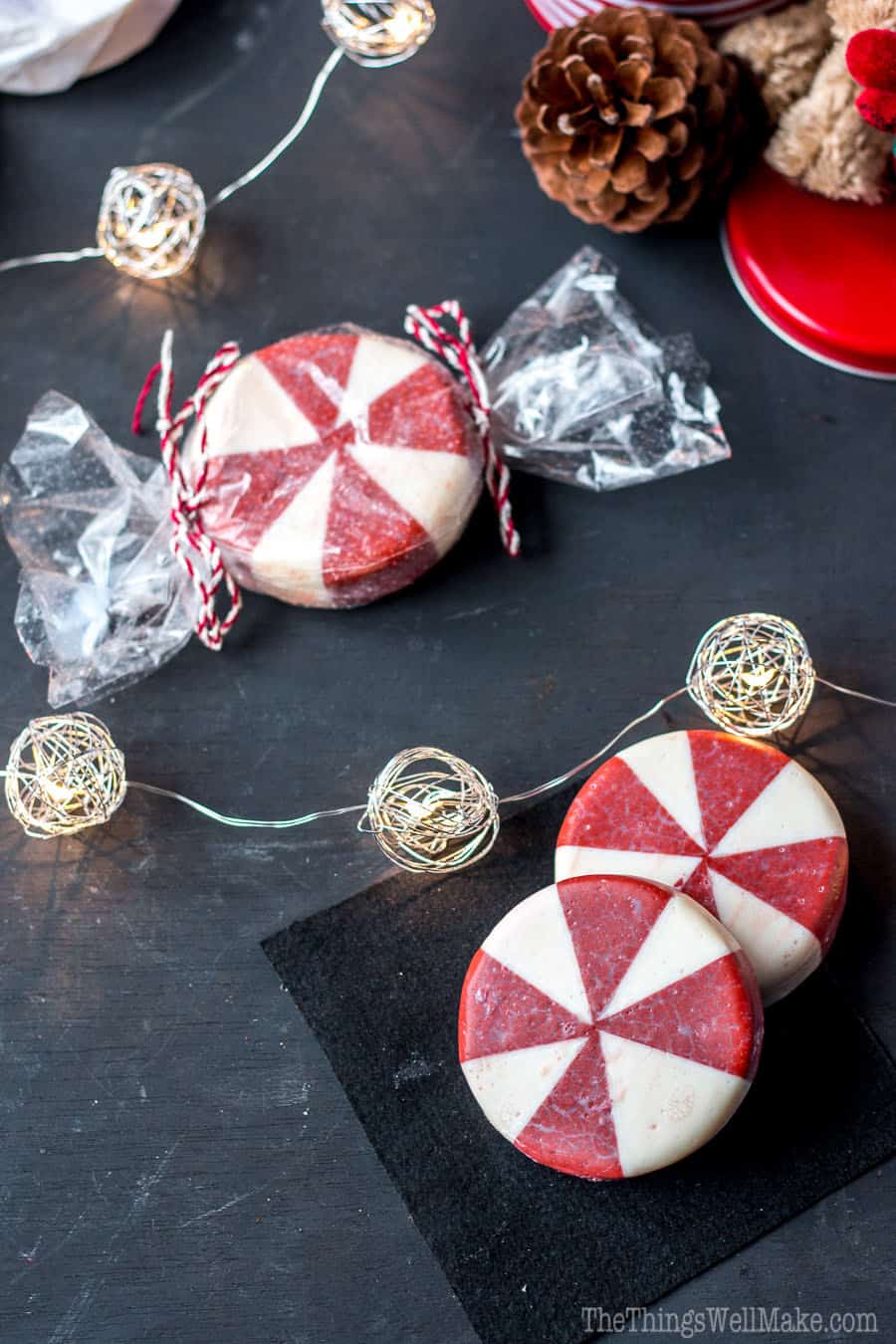
Christmas Candy Holiday Peppermint Soap
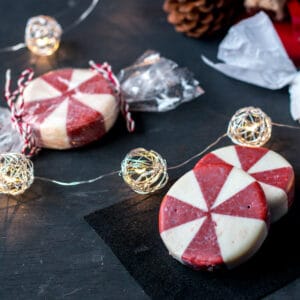
Peppermint Soap
Materials
- 90 g lard or tallow
- 105 g olive oil
- 90 g coconut oil
- 15 g castor oil
- 114 g distilled water
- 43 g lye
- 8 g peppermint essential oil
- red iron oxide
- titanium dioxide
Instructions
- Just as in previous soaps, add the lye to the water (not the other way around), and mix them until the lye is fully dissolved. It will heat up and get cloudy, but will then clear again as it cools.
- While the lye is cooling, prepare your mold by greasing a PVC pipe with a tiny bit of any of your oils. Cover one end with wax paper, parchment paper or some relatively thick plastic film (like plastic taken from a freezer bag). Secure the paper or plastic with a tight rubber band (or two).
- Measure out the oils and combine them. I use a hand held blender to help combine the solid oils into the liquid ones, but if you are having a hard time of combining the oils, you can slightly heat the solid oils to melt them.
- Add the lye mixture to the oil mixture and begin by mixing them together gently. Once they are well combined, you can begin blending them with an immersion blender until it begins to emulsify and look like a thin mayonnaise.
- Once you have reached the thin mayonnaise state, also known as “trace,” you will want to add in the peppermint essential oil (or scented oil), and enough red iron oxide to get the desired color. I didn’t really mix out the iron oxide, and just added around 1/4 tsp. and blended it in to see how bright the mixture became. I then added more as needed. Start out with a small amount. You can always add more. As for the peppermint essential oil, I added in enough to get a nice peppermint scent, but I didn’t really add much, and my soap lost a lot of its scent after a month or so. Next time I would definitely add in more.
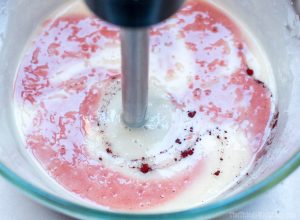
- Pour the mixture into the prepared PVC pipe, and wrap it with towels to help keep the heat in. In the rest of my soaps so far, this wasn’t really a necessary step, but by insulating the soap when it is first poured into the molds, you will help the soap get to what is called the “gel phase.” Reaching the gel phase helps to brighten the colors of a soap and may also make it slightly harder faster because more of the liquid may evaporate. Both of those qualities are perfect for a soap like this one.
- After a day or two, check on the soap. It should be relatively solid to the touch. If it isn’t, leave it for another day, and check again. If it is, unwrap the mold, and place it into the freezer for several hours. This will help harden the soap so that you can umold it without damaging it. It will also help shrink the soap slightly so that it is easier to remove it from the mold.
- Scrape off any excess soap from the bottom of the mold, smoothing it out with a knife.
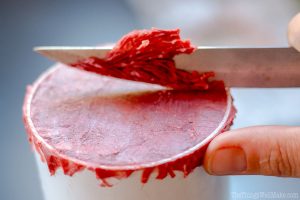
- Push the soap out of the mold by pressing on it from the inside. I used a thermos bottle with a flat bottom to push the soap out of the mold.
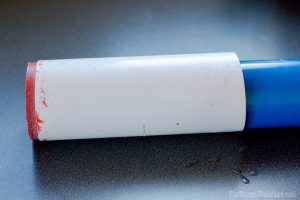
- Once the soap has been removed from the mold, you’ll want to cut off any uneven bits to smooth off the top part of the soap.
- With the soap in a vertical position, cut the soap in half, and then in half again in the other direction. (Think of how you would cut a pizza into slices.) Then make two more cuts dividing each quarter in half to get eight even sections of soap.
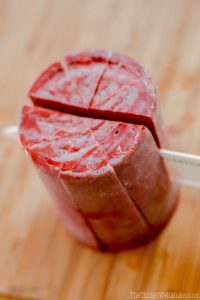
- I tried to use one pvc pipe for both layers of my soap, but the top layer pushed the bottom sections out of position and my bottom layer of soap wasn’t as pretty as the top layers. I suggest using two pieces of PVC pipe of the same size instead.
- Prepare both PVC pipes as before by greasing them and covering one of the ends. Next, insert 4 pieces of red soap into each pipe, leaving even spaces between each piece for the white soap.
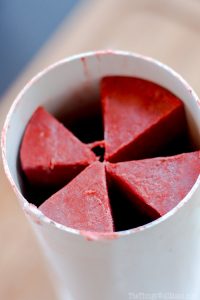
- Prepare the above recipe once more as you did in the first steps, this time adding titatnium dioxide, instead of the red iron oxide, to get a white colored soap.
- Pour the white soap into the spaces between the red sections of soap, dividing the soap equally amongst the two molds.
- Cover the soap with a towel and allow the soap to rest for a day or two.
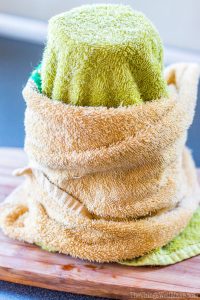
- Once again, check on the soap, and place it into the freezer for several hours to help unmold it. Push the soap out of the mold, and cut it into bars of soap that should resemble peppermint patties. (You can see that the bottom section of my soap is all white on the outside because my bottom red soap pieces got pushed to the center by the top ones. That’s why I suggest using 2 separate molds instead.
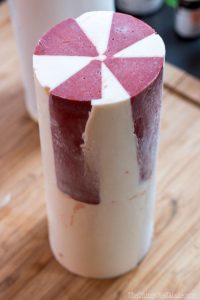
- Allow the soap to dry for several weeks, flipping it over occasionally to help the soap dry evenly.
- As you use the soap, it should get rounded edges that will make it look more like a peppermint candy, but if you want to gift the soap or are in a hurry to get it to look like mine, you can scrape the edges of the soap lightly with a knife to help round them, and then smooth it out by rubbing the soap under some warm water.
- Wrap the soap to look like candies by wrapping them in cellophane, and tying either side with a ribbon or some bakers twine. If you’re especially crafty, you can make your own bakers twine like I did.
 Español
Español
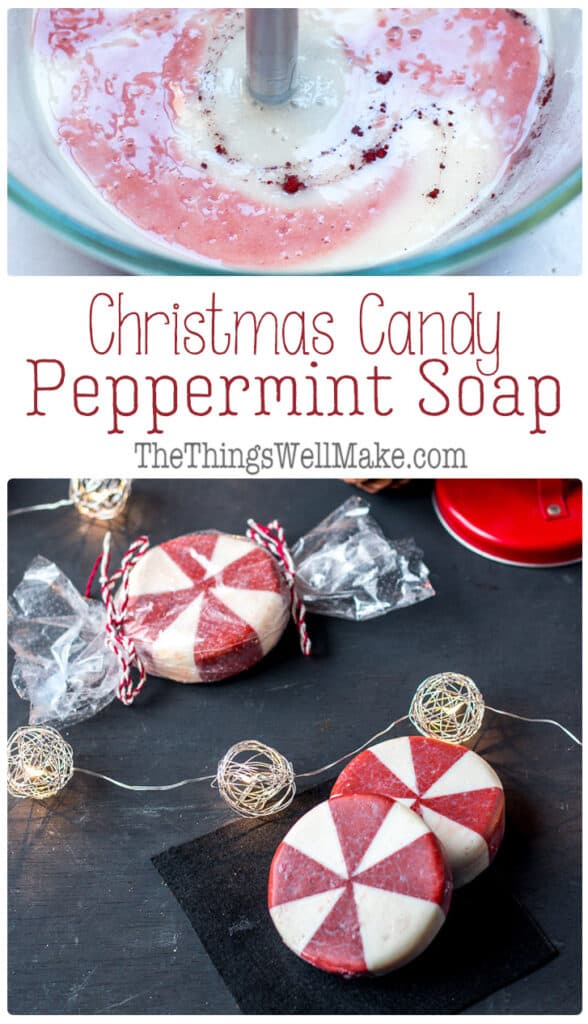
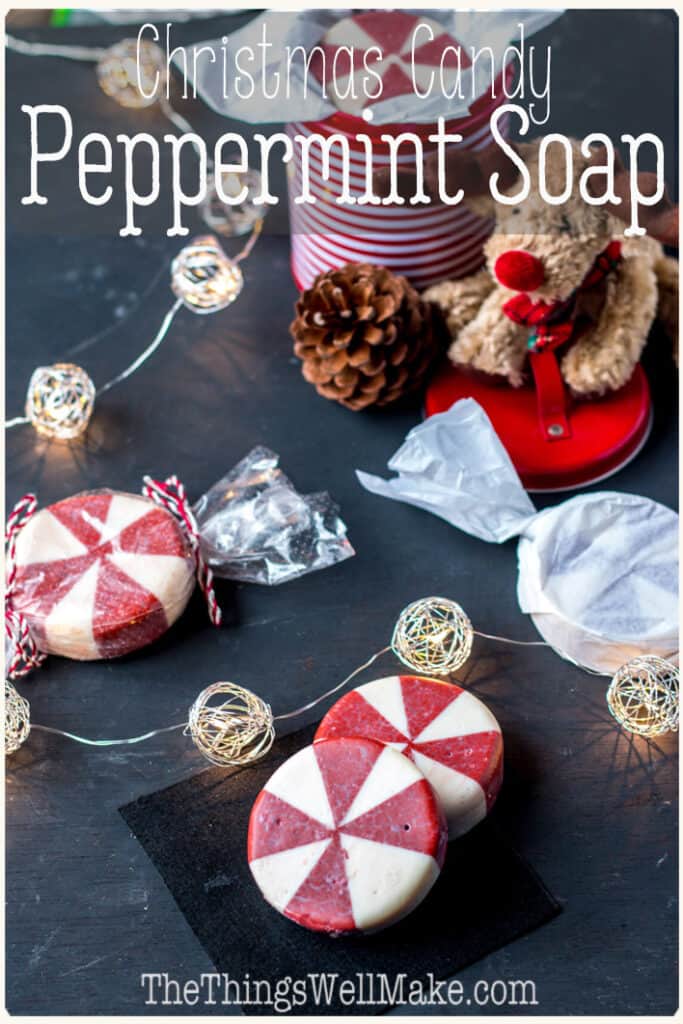
 Paleo Doritos Like Chips Recipe
Paleo Doritos Like Chips Recipe
Morgan
How large was the PVC pipe?
Tracy Ariza
Hi Morgan,
I’m sorry, I put off answering your question because I was going to look for the pipe to measure it, but the weather has been bad- windy and rainy- which has kept me from running to our shed to look for it. 😉
Today, though, I thought it might be easier to check a remaining soap I had in the kitchen. I’ve worn it down a bit with use, but not much. It’s almost 3 inches in diameter, so I’d guess that was the size of the opening of the pipe.